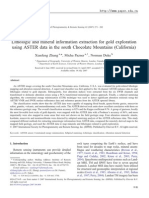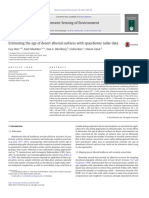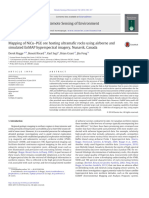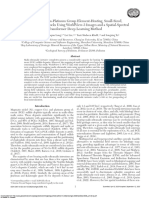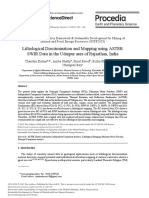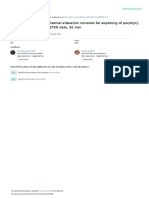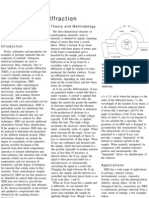Zona Alterasi From ASTER
Zona Alterasi From ASTER
Uploaded by
Rangga ParadityaCopyright:
Available Formats
Zona Alterasi From ASTER
Zona Alterasi From ASTER
Uploaded by
Rangga ParadityaCopyright
Available Formats
Share this document
Did you find this document useful?
Is this content inappropriate?
Copyright:
Available Formats
Zona Alterasi From ASTER
Zona Alterasi From ASTER
Uploaded by
Rangga ParadityaCopyright:
Available Formats
INT. J. REMOTE SENSING, VOL.
24,
NO.
10 21, 42334240
NOVEMBER,
2003,
Targeting key alteration minerals in epithermal deposits in Patagonia, Argentina, using ASTER imagery and principal component analysis
A. P. CROSTA*, C. R. DE SOUZA FILHO
Geosciences Institute, University of Campinas, PO Box 6152, 13081-970, Campinas, SP, Brazil
F. AZEVEDO and C. BRODIE
Downloaded by [Gadjah Mada University] at 17:30 16 October 2011
IAMGOLD Argentina SA, Mendoza, Argentina (Received 5 September 2002; in nal form 20 May 2003 ) Abstract. Principal component analysis (PCA) is an image processing technique that has been commonly applied to Landsat Thematic Mapper (TM) data to locate hydrothermal alteration zones related to metallic deposits. With the advent of the Advanced Spaceborne Thermal Emission and Reection Radiometer (ASTER), a 14-band multispectral sensor operating onboard the Earth Observation System (EOS)-Terra satellite, the availability of spectral information in the shortwave infrared (SWIR) portion of the electromagnetic spectrum has been greatly increased. This allows detailed spectral characterization of surface targets, particularly of those belonging to the groups of minerals with diagnostic spectral features in this wavelength range, including phyllosilicates (clay minerals), sulphates and carbonates, among others. In this study, PCA was applied to ASTER bands covering the SWIR with the objective of mapping the occurrence of mineral endmembers related to an epithermal gold prospect in Patagonia, Argentina. The results illustrate ASTERs ability to provide information on alteration minerals which are valuable for mineral exploration activities and support the role of PCA as a very effective and robust image processing technique for that purpose.
1.
Introduction Spectral identication of potential areas of hydrothermal alteration minerals is a common application of remote sensing to mineral exploration. The extraction of spectral information related to this type of target from Landsat Thematic Mapper (TM) imagery has been achieved through the use of image processing techniques such as band ratioing and principal component analysis (PCA) (Sabine 1999). With the limited spectral resolution provided by Landsat TM, alteration mapping has been restricted to the detection of areas where alteration processes are likely to have occurredthe TM visible and near-infrared (VNIR) and shortwave infrared (SWIR) bands are only able to discriminate areas rich in iron oxides/
*Corresponding author; e-mail: alvaro@ige.unicamp.br
International Journal of Remote Sensing ISSN 0143-1161 print/ISSN 1366-5901 online # 2003 Taylor & Francis Ltd http://www.tandf.co.uk/journals DOI: 10.1080/0143116031000152291
4234
A. P. Crosta et al.
hydroxides and clay and carbonate minerals, respectively. However, with the spectral resolution provided by the Advanced Spaceborne Thermal Emission and Reection Radiometer (ASTER), identication of specic alteration assemblages becomes feasible, since it has six spectral bands in the SWIR (bands 49) (Abrams 2000), a region where many clay and carbonate minerals show diagnostic spectral features, compared to only two TM bands (TM5 and TM7). In this Letter, the capability of ASTER bands to discriminate alteration minerals related to an epithermal gold prospect in northern Patagonia, Argentina, using a simple, yet robust, image processing technique to produce mineral abundance maps from ASTER bands, is demonstrated. Background Most of the variation of radiant spectral ux measured by a sensor depends on topographic shading and albedo effects at the surface. PCA is a powerful statistical technique that can be used for suppressing irradiance effects that dominate all bands, therefore enhancing spectral reectance features of geological materials. PCA can be applied to multivariate datasets, such as multispectral remote sensing images, with the purpose of extracting specic spectral responses, as in the case of hydrothermal alteration minerals. Crosta and Moore (1989) developed a technique based on PCA for mapping iron oxide/hydroxides related to sulphide ore bodies in granitegreenstone belt terrains using Landsat TM. The technique, called feature-orientated principal component selection (FPCS), relied on establishing the relationship between the spectral responses of target materials (ferric-oxide-rich soils) and numeric values extracted from the eigenvector matrix used to calculate the principal component (PC) images. Using this relationship, they were able to determine which PCs contained the spectral information due to iron minerals and whether the digital numbers (DNs) of pixels containing the target materials had high (bright) or low (dark) values. Loughlin (1991) modied the FPCS technique by selecting specic Landsat TM band sets and applying PCA separately to them, to ensure that certain materials (e.g. vegetation) would not be mapped and that spectral information due to target materials (alteration minerals) would be mapped into a single PC. The procedure proposed by Loughlin used Landsat TM band sets comprising bands 1, 3, 4 and 5 for deriving spectral information related to ferric oxides/hydroxides, which would be uniquely mapped into either PC3 or PC4. Another band set, comprising bands 1, 4, 5 and 7, was similarly used to derive information related to hydroxyl-bearing minerals and carbonates, also uniquely mapped into either PC3 or PC4. This procedure, coined by Loughlin (1991) the Crosta technique, has been successfully used for mineral exploration purposes due to its ease of use and robustness (Bastianelli et al. 1993, Davidson et al. 1993, Ruiz-Armenta and Prol-Ledesma 1998, Souza Filho and Drury 1998, Tangestani and Moore 2001, 2002, Carranza and Hale 2002). In regions subject to mineral exploration and with favourable conditions (sparse or no vegetation, exposed bedrock, etc.), such as in the South American Cordillera, this technique has become a standard operational tool for alteration mapping using Landsat TM. The idea of applying PCA to derive mineral abundance maps using high spectral resolution data was proposed by Crosta et al. (1996) and Prado and Crosta (1997). They used 24-band Geoscan data, covering the VNIR, SWIR and thermal infrared (TIR) portions of the electromagnetic spectrum (a similar spectral coverage to that 2.
Downloaded by [Gadjah Mada University] at 17:30 16 October 2011
Remote Sensing Letters
4235
provided by ASTER), to produce abundance images of hematite, goethite, calcite chlorite, muscovitesericitekaolinite and silica concentrations, related to gold mineralization in hydrothermally altered greenstone belt rocks. Los Menucos gold prospects Los Menucos region is located in the northern portion of Patagonia, Argentina, where epithermal gold mineralization, related to hydrothermally altered Triassic Jurassic acidic to intermediate volcanics (Cucchi et al. 1999), is currently the focus of exploration efforts. Cerro Abanico and Cerro La Mina are the known largest prospects, located within a NESW oriented half-graben some 40 km long by 10 km wide. At Cerro Abanico, quartz and quartzadularia veins cut dacitic to rhyolitic ignimbrites, sediments and tuffs. Alteration assemblages are typically quartzillite and pyrite. At Cerro La Mina, alteration minerals include both, high- and lowsulphidation assemblages, comprising kaolinite, alunite, illitemuscovite, dickite, quartz and adularia and have affected a sequence of andesite to rhyolite lava domes. Mineralization is hosted in breccias. ASTER data ASTER is a joint development between the United States and Japan, with a strong focus on geological and mineral exploration applications. The sensor has 14 spectral bandsthree in the VNIR (0.520.86 mm) with 15-m spatial resolution, six in the SWIR (1.602.43 mm) with 30-m resolution, and ve in the TIR (8.125 11.65 mm) with 90-m resolution (Abrams 2000). Of particular interest to alteration mineral mapping are the SWIR bands, located at wavelength intervals where numerous clay (alteration) minerals exhibit diagnostic spectral features (Rowan and Mars 2003). 5. Mineral endmember identication using PCA of ASTER bands PCA was applied to subsets of four ASTER bands, using an adaptation of the Crosta technique proposed by Loughlin (1991). The subsets were selected according to the position of characteristic spectral features of key alteration mineral endmembers (table 1) in the VNIR and SWIR portions of the spectrum. After applying PCA, the eigenvector matrix used to calculate PCA for each subset was examined, to identify which PC contained the target (mineral) information. The criterion for the identication is the same proposed by Loughlin (1991): the PC that contains the target spectral information shows the highest eigenvector loadings from the ASTER bands, coinciding with the targets most diagnostic
Table 1. ASTER bands (VNIRzSWIR) used to generate mineral abundance maps in the Los Menucos area through PCA. Wavelength ranges (in mm) are: band 1, 0.520 0.600; band 3, 0.7600.860; band 4, 1.6001.700; band 5, 2.1452.185; band 6, 2.185 2.225; band 7, 2.2352.285; and band 9, 2.2352.285. Alteration minerals Alunite ASTER bands 1 3 5 7 Illite 1 3 5 6 Kaolinitezsmectite 1 4 6 9 Kaolinite 1 4 6 7
3.
Downloaded by [Gadjah Mada University] at 17:30 16 October 2011
4.
4236
A. P. Crosta et al.
Table 2. Eigenvector statistics for ASTER bands 1, 4, 6 and 7. This band set was selected for identifying spectral response from kaolinite. PC4 will depict the pixels likely to contain kaolinite due largely to the spectral contrast between bands 4 and 6, minimizing spectral response from other surface materials. PC1 Band Band Band Band 1 4 6 7 0.667 0.441 0.443 0.406 PC2 20.722 0.384 0.217 0.532 PC3 0.179 20.258 20.648 0.694 PC4 20.039 20.769 0.580 0.266
Downloaded by [Gadjah Mada University] at 17:30 16 October 2011
features, but with opposite signs (z or 2). For example, kaolinite has high reectance values in ASTER bands 4 and 7 and absorbs strongly in bands 1 and 6; the PCA eigenvector statistics of these bands (table 2) shows that PC4 has a high and negative loading from band 4 (20.769) and high and positive loading from band 6 (0.580), indicating that pixels likely to contain kaolinite will be represented by low (dark) DN values in PC4. Loadings for bands 1 and 7 show signicantly lower values (20.039 and 0.266, respectively), indicating that the relevant spectral
Figure 1. Abundance images of Los Menucos for (a) alunite, (b) illite, (c) kaolinite/smectite and (d ) kaolinite, produced using PCA of ASTER bands. The images are approximately 30 km across.
Remote Sensing Letters
4237
Downloaded by [Gadjah Mada University] at 17:30 16 October 2011
information will be shown by the spectral contrast of kaolinite in the wavelength positions equivalent to bands 4 and 6. To facilitate visualization, the PC4 image is then negated (by multiplying all pixels by 21), so that the target material is displayed as bright pixels in the respective abundance image (gure 1(d)). Mineral abundance images of Los Menucos were produced from ASTER bands using PCA, each one showing areas most likely to contain the alteration minerals listed in table 1. These abundance images are shown in gure 1, with bright DN values indicating high abundances. A red, green, blue (RGB) colour composite of abundance images for kaolinite, illite and alunite is presented in gure 2, draped over ASTER band 3. All the altered areas known in the Los Menucos district are distinctively represented in this image in different colours. These results were checked against eld spectroscopy data on three selected sites, whose locations are shown in gure 2 as P1, P2 and P3. At each site, a number of spectral measurements were taken using a PIMA (Portable Infrared Mineral Analyzer) reectance spectrometer. An average spectrum was produced for each site and then classied with reference to the US Geological Survey (USGS) mineral spectra library using the Spectrometer Independent Mineral Identication Software (SIMIS) spectral analysis package (Mackin 2002). Figure 3 presents the results of the spectral analysis, which identied the major mineral component at P1 as being
Figure 2. Colour composite of abundance images for kaolinite, illite and alunite in RGB, draped over ASTER band 3. The village of Los Menucos is at the upper right corner of the scene.
4238
A. P. Crosta et al.
Downloaded by [Gadjah Mada University] at 17:30 16 October 2011
Figure 3. Comparison of spectra collected at sites P1 (a), P2 (b) and P3 (c) (see gure 2 for location) with the spectra of the main minerals identied by the SIMIS spectral analysis package. Field spectra were collected using a PIMA portable reectance spectrometer. Reference spectra used for the analysis came from the USGS mineral spectra library. Differences in reectance values between each pair of spectra are due to grain size effects. Spectra from the USGS library, measured from ne grain samples, show higher reectance values in comparison with PIMA spectra, measured directly from rock samples in the eld.
Remote Sensing Letters
4239
illite (gure 3(a)), at P2 as alunite (gure 3(b)) and at P3 as kaolinite (gure 3(c)). Comparing these results with the RGB image of kaolinite, illite and alunite (gure 2), it is possible to verify that the colour at P1 is yellow, indicating a mixture of illite and kaolinite; at P2 is magenta, indicating a mixture of alunite and kaolinite; and at P3 is red, indicating kaolinite. These results are in agreement with the minerals identied by the PCA method at each site and provide qualitative evidence to support the validity of the method. Considering the coarse spatial resolution and limited spectral resolution of ASTER imagery, the images presented in gures 1 and 2 are depicting the major mineralogy of the alteration zones at Los Menucos, on a pixel basis over continuous ground surfaces. In fact, the image shown in gure 2 is currently being used in the eld as an alteration map to guide exploration activities in the region.
Downloaded by [Gadjah Mada University] at 17:30 16 October 2011
6.
Discussion and conclusions Extracting mineral signatures from high spectral resolution images is not an easy task and usually depends on the availability of specic image processing tools, such as hyper-spectral classiers and reference spectra. On the other hand, PCA is an easy-touse technique that has been widely employed for more than a decade and has become a standard in the mineral industry for alteration mapping using Landsat TM. The results obtained for the Los Menucos area demonstrate that PCA can extract detailed mineralogical information from ASTER multispectral data, in order to produce abundance images for some alteration minerals widely used in exploration for precious and base-metal deposits. This simple, fast and robust technique can also be adapted to bandpasses of hyper-spectral resolution sensors, such AVIRIS, HyMap and Hyperion, for processing large volumes of data worldwide. Acknowledgments The authors would like to thank M. Abrams (NASA/Jet Propulsion Laboratory), for discussion on ASTER data characteristics and quality, and IAMGOLD Corporation, Toronto, for releasing the results for publication. A. P. Crosta and C. R. Souza Filho were supported by research grants from Fundacao de Amparo a ` Pesquisa do Estado de Sao Paulo (FAPESP) and Conselho Nacional de Desenvolvi mento Cientco e Tecnologico (CNPq), Brazil. References
ABRAMS, M., 2000, The Advanced Spaceborne Thermal Emission and Reection Radiometer (ASTER): data products for the high spatial resolution imager on NASAs Terra platform. International Journal of Remote Sensing, 21, 847859. BASTIANELLI, L., BELA, G. D., and TARSI, L., 1993, Alteration mapping: a case study in mid-south Bolivia. Proceedings of the 9th Thematic Conference on Geologic Remote Sensing, Pasadena, CA (Ann Arbor, MI: Environmental Research Institute of Michigan), pp. 11331144. CARRANZA, E. J. M., and HALE, M., 2002, Mineral imaging with Landsat Thematic Mapper data for hydrothermal alteration mapping in heavily vegetated terrain. International Journal of Remote Sensing, 23, 48274852. CROSTA, A. P., and MOORE, J. MCM., 1989, Enhancement of Landsat Thematic Mapper imagery for residual soil mapping in SW Minas Gerais State Brazil: a prospecting case history in greenstone belt terrain. Proceedings of the 9th Thematic Conference on Remote Sensing for Exploration Geology, Calgary (Ann Arbor, MI: Environmental Research Institute of Michigan), pp. 11731187. CROSTA, A. P., PRADO, I. D. M., and OBARA, M., 1996, The use of Geoscan AMSS Mk-II data for gold exploration in the Rio Itapicuru greenstone belt, Bahia, Brazil.
4240
Remote Sensing Letters
Downloaded by [Gadjah Mada University] at 17:30 16 October 2011
Proceedings of the 11th Thematic Conference on Remote Sensing for Exploration Geology, Las Vegas, NV (Ann Arbor, MI: Environmental Research Institute of Michigan), pp. 205214. CUCCHI, R., BUSTEROS, A., LEMA, H., DALPONTE, M., and ESPEJO, P., 1999, Geologia Y Recursos Minerales de Hoja 4169-II, Los Menucos (Viedma, Rio Negro: SEGEMAR/ Direccion de Mineria de Rio Negro). DAVIDSON, D., BRUCE, B., and JONES, D., 1993, Operational remote sensing mineral exploration in a semi-arid environment: the Troodos Massif, Cyprus. Proceedings of the 9th Thematic Conference on Remote Sensing for Exploration Geology, Pasadena, CA (Ann Arbor, MI: Environmental Research Institute of Michigan), pp. 845859. LOUGHLIN, W., 1991, Principal component analysis for alteration mapping. Photogrammetric Engineering and Remote Sensing, 57, 11631169. MACKIN, S., 2002, SIMIS Feature Search 1.5 User Manual. PRADO, I. D. M., and CROSTA, A. P., 1997, Evaluating Geoscan AMSS Mk-II for gold exploration in the Fazenda Maria Preta District, Rio Itapicuru greenstone belt, Bahia State, Brazil. Boletim IG-USP, 28, 6384. ROWAN, L. C., and MARS, J. C., 2003, Lithologic mapping in the Mountain Pass, California, using Advanced Spaceborne Thermal Emission and Reection Radiometer (ASTER) data. Remote Sensing of Environment, 84, 350366. RUIZ-ARMENTA, J. R., and PROL-LEDESMA, R. M., 1998, Techniques for enhancing the spectral response of hydrothermal alteration minerals in Thematic Mapper images of Central Mexico. International Journal of Remote Sensing, 19, 19812000. SABINE, C., 1999, Remote sensing strategies for mineral exploration. In Remote Sensing for the Earth SciencesManual of Remote Sensing, 3rd edn, edited by A. Rencz (New York: American Society of Photogrammetry and Remote Sensing/John Wiley and Sons), pp. 375447. SOUZA FILHO, C. R., and DRURY, S. A., 1998, Evaluation of JERS-1 (FUYO-1) OPS and Landsat TM images for mapping of gneissic rocks in arid areas. International Journal of Remote Sensing, 19, 35693594. TANGESTANI, M. H., and MOORE, F., 2001, Comparison of three principal component analysis techniques to porphyry copper alteration mapping: a case study in Meiduk area, Kerman, Iran. Canadian Journal of Remote Sensing, 27, 176182. TANGESTANI, M. H., and MOORE, F., 2002, Porphyry copper alteration mapping at the Meiduk area, Iran. International Journal of Remote Sensing, 23, 48154826.
You might also like
- Jindal Processing ESIA DSR v0Document128 pagesJindal Processing ESIA DSR v0kselvan_1100% (1)
- Deposit Sedex GoodfellowDocument16 pagesDeposit Sedex Goodfellowgeology1100% (1)
- Targeting Key Alteration Minerals in Epithermal deDocument9 pagesTargeting Key Alteration Minerals in Epithermal deابوبكر عبد الباقيNo ratings yet
- Zhangxianfeng Self 200802 10 PDFDocument0 pagesZhangxianfeng Self 200802 10 PDFMenur Mandriati SudrajatNo ratings yet
- Ninomiya 2002Document12 pagesNinomiya 2002Oskar CahuayaNo ratings yet
- Mapping of Mineral Resources and Lithological Units A Review of Remote Sensing TechniquesDocument29 pagesMapping of Mineral Resources and Lithological Units A Review of Remote Sensing TechniquesAbdullah Bello MuhammedNo ratings yet
- Continuous Mineral Mapping of Core Using Hyperspectral Imaging: Example From The Upper Cretaceous Austin Chalk Marathon 1 RobertTodd Core, Central LouisanaDocument9 pagesContinuous Mineral Mapping of Core Using Hyperspectral Imaging: Example From The Upper Cretaceous Austin Chalk Marathon 1 RobertTodd Core, Central LouisanahijoetigreNo ratings yet
- Lithology Identification of The North Qilian Belt by Surface Temperature and Spectral Emissivity Information Derived From ASTER TIR DataDocument5 pagesLithology Identification of The North Qilian Belt by Surface Temperature and Spectral Emissivity Information Derived From ASTER TIR DataSrikanth JutruNo ratings yet
- Ore Geology Reviews: Safwat Gabr, Abduwasit Ghulam, Timothy KuskyDocument11 pagesOre Geology Reviews: Safwat Gabr, Abduwasit Ghulam, Timothy KuskyJULIO JEAN CONDEZO AGUILARNo ratings yet
- 10 1109@igarss 2001 976615Document3 pages10 1109@igarss 2001 976615Oskar CahuayaNo ratings yet
- KaolitDocument6 pagesKaolitamaNo ratings yet
- Emegeo 10Document6 pagesEmegeo 10Srikanth Jutru100% (1)
- Copper Mapping PDFDocument9 pagesCopper Mapping PDFnasir.hdip8468No ratings yet
- Isprs Archives XLII 2 W13 1255 2019Document8 pagesIsprs Archives XLII 2 W13 1255 2019David PradaNo ratings yet
- Some Applications of The Remote Sensing PDFDocument7 pagesSome Applications of The Remote Sensing PDFMinep LimitadaNo ratings yet
- Chemical analysis of a lunar meteorite by laser ablation mass spectrometryDocument6 pagesChemical analysis of a lunar meteorite by laser ablation mass spectrometrywanderson.limeiraaNo ratings yet
- Carter 2012Document4 pagesCarter 2012Maria Victoria Rojas328No ratings yet
- HertzDocument14 pagesHertzDaniel Baptista VioNo ratings yet
- Geocarto_2020_compressedDocument32 pagesGeocarto_2020_compressediman maasoumiNo ratings yet
- Casey KaabSupraglacial Khumbu tc-6-85-2012Document16 pagesCasey KaabSupraglacial Khumbu tc-6-85-2012Shruti DuttaNo ratings yet
- AISADocument16 pagesAISA673555014qqNo ratings yet
- 10.1007@s12517 020 5148 8 PDFDocument12 pages10.1007@s12517 020 5148 8 PDFDr. Kiran YarrakulaNo ratings yet
- 5056 - Yin Et AlDocument16 pages5056 - Yin Et AlEdilberNo ratings yet
- Yamaguchi TRES 24-22-06Document13 pagesYamaguchi TRES 24-22-06Rodrigo PeraltaNo ratings yet
- Jing - 2014 - Regional-Scale Mineral Mapping Using ASTER VNIR - SWIR Data and Validation of Reflectance and Mineral Map PDFDocument15 pagesJing - 2014 - Regional-Scale Mineral Mapping Using ASTER VNIR - SWIR Data and Validation of Reflectance and Mineral Map PDFRoberto MoraNo ratings yet
- Utilization of ASTER Data in Lithological and LineDocument20 pagesUtilization of ASTER Data in Lithological and LineLamsalah HamzaNo ratings yet
- Using ASTER Image Processing For Hydrothermal Alteration and Key Alteration Minerals Mapping in Siyahrud Area, IRANDocument6 pagesUsing ASTER Image Processing For Hydrothermal Alteration and Key Alteration Minerals Mapping in Siyahrud Area, IRANArif HidayatNo ratings yet
- 23 - Prado Et Al - HiperspectralDocument23 pages23 - Prado Et Al - Hiperspectraldaiane.munchNo ratings yet
- Iran Landsat 8 OliDocument43 pagesIran Landsat 8 Olijavish asteteNo ratings yet
- Use of Insar For Monitoring of Mining DeformationsDocument6 pagesUse of Insar For Monitoring of Mining DeformationsRezaNo ratings yet
- China Aster-LandsatDocument23 pagesChina Aster-Landsatjavish asteteNo ratings yet
- TFM GiselaBarroso v2 ALoboDocument40 pagesTFM GiselaBarroso v2 ALoboJoão JúniorNo ratings yet
- Photogeological Interpretation of Satellite Images: July 2006Document8 pagesPhotogeological Interpretation of Satellite Images: July 2006Francisco Ibar Tapia GuerraNo ratings yet
- Kumar 2015Document9 pagesKumar 2015Stalin BryanNo ratings yet
- Coral Reef Habitat Mapping: How Much Detail Can Remote Sensing Provide?Document10 pagesCoral Reef Habitat Mapping: How Much Detail Can Remote Sensing Provide?DewaNo ratings yet
- Mining 04 00018Document24 pagesMining 04 00018Lamsalah HamzaNo ratings yet
- Mapping of Manganese Potential Areas Usi 2Document10 pagesMapping of Manganese Potential Areas Usi 2Rajesh SahooNo ratings yet
- The Detection of Potassic Alteration by Gamma Ray Spectrometry - Recognition of Alteration Related To MineralizationDocument17 pagesThe Detection of Potassic Alteration by Gamma Ray Spectrometry - Recognition of Alteration Related To MineralizationYamirNo ratings yet
- ASTER Capability in Mapping of Mineral Resources of Arid Region A Review On Mapping of Mineral Resources of The Sultanate of Oman PDFDocument21 pagesASTER Capability in Mapping of Mineral Resources of Arid Region A Review On Mapping of Mineral Resources of The Sultanate of Oman PDFCarlos Alquinta PNo ratings yet
- Hassan - 2014 - Spectral Analyses of Basement Rocks in El-Sibai-Umm Shaddad, Central Eastern Desert, Egypt, Using ASTER TIRDocument14 pagesHassan - 2014 - Spectral Analyses of Basement Rocks in El-Sibai-Umm Shaddad, Central Eastern Desert, Egypt, Using ASTER TIRRoberto MoraNo ratings yet
- Ex06 - Research Methods Report - GISN27 - Kaleab WoldemariamDocument14 pagesEx06 - Research Methods Report - GISN27 - Kaleab WoldemariamKaleab WoldemariamNo ratings yet
- EGJG - Volume 62 - Issue 1 - Pages 133-150Document18 pagesEGJG - Volume 62 - Issue 1 - Pages 133-150rahmaasamymohamedNo ratings yet
- Porphyry AlterationDocument16 pagesPorphyry AlterationJiguur BayasgalanNo ratings yet
- Remote Sensing For Gold Exploration Remote Sensing For Gold ExplorationDocument11 pagesRemote Sensing For Gold Exploration Remote Sensing For Gold ExplorationJesus CamachoNo ratings yet
- Rajendran Et Al 2019Document21 pagesRajendran Et Al 2019Rogger Miguel Jaramillo ChungaNo ratings yet
- Zeraietal2023 NaturalResourcesResearch MineralprospectivitymappingeritreaDocument31 pagesZeraietal2023 NaturalResourcesResearch Mineralprospectivitymappingeritream.eljanatiNo ratings yet
- XRDDocument2 pagesXRDsquirellNo ratings yet
- Hyperion Data For Iron Oxide MappingDocument9 pagesHyperion Data For Iron Oxide MappingIqra AyeshaNo ratings yet
- Thompson Etal 1999 SEG Alteration-Mapping-in-ExplorationDocument13 pagesThompson Etal 1999 SEG Alteration-Mapping-in-ExplorationEvelyn Karina Caiza CañarNo ratings yet
- EtatfDocument7 pagesEtatfAstroteck Daniel EduardoNo ratings yet
- Ground Penetrating Radar (GPR) For SubsurfaceDocument18 pagesGround Penetrating Radar (GPR) For Subsurfaceroland100% (1)
- Ahmad 2015Document9 pagesAhmad 2015Iqra AyeshaNo ratings yet
- OF2012-1105 TextDocument8 pagesOF2012-1105 TextItalo MelgarNo ratings yet
- Aircraft and Satellite Remote Sensing of Desert Soils and LandscapesDocument19 pagesAircraft and Satellite Remote Sensing of Desert Soils and LandscapeswubegzierNo ratings yet
- Customized Spectral Libraries For Effect PDFDocument18 pagesCustomized Spectral Libraries For Effect PDFHugo Poma FernándezNo ratings yet
- Full PaperDocument16 pagesFull PaperJavier RojasNo ratings yet
- Newsletter: Alteration Mapping in Exploration: Application of Short-Wave Infrared (SWIR) SpectrosDocument14 pagesNewsletter: Alteration Mapping in Exploration: Application of Short-Wave Infrared (SWIR) SpectrosJuan Taipe RodriguezNo ratings yet
- Geosciences 06 00039Document52 pagesGeosciences 06 00039Gustavo MateoNo ratings yet
- Oil and Gas Exploration: Methods and ApplicationFrom EverandOil and Gas Exploration: Methods and ApplicationSaid GaciNo ratings yet
- Introduction To Optical Mineralogy And Petrography - The Practical Methods Of Identifying Minerals In Thin Section With The Microscope And The Principles Involved In The Classification Of RocksFrom EverandIntroduction To Optical Mineralogy And Petrography - The Practical Methods Of Identifying Minerals In Thin Section With The Microscope And The Principles Involved In The Classification Of RocksRating: 3.5 out of 5 stars3.5/5 (2)
- Atlas of Antarctica: Topographic Maps from Geostatistical Analysis of Satellite Radar Altimeter DataFrom EverandAtlas of Antarctica: Topographic Maps from Geostatistical Analysis of Satellite Radar Altimeter DataNo ratings yet
- Finding Oil and Gas From Well Logs (L.M. Etnyre, 1989) @geo PediaDocument312 pagesFinding Oil and Gas From Well Logs (L.M. Etnyre, 1989) @geo Pediaefenix_89No ratings yet
- Salahaddin UniversityDocument17 pagesSalahaddin UniversityBkhwena eduNo ratings yet
- Characterization of Heterogenous Near-Surface MateDocument5 pagesCharacterization of Heterogenous Near-Surface MateGhulam Mohyuddin SohailNo ratings yet
- The Driftless AreaDocument4 pagesThe Driftless Areacarl_j_sorensenNo ratings yet
- The 2 Earthquakes of February 6 2023 in Turkey: Preliminary ReportDocument45 pagesThe 2 Earthquakes of February 6 2023 in Turkey: Preliminary ReportVlad Arenales MorenoNo ratings yet
- Ground Improvement Techniques For Stabilization of Different SoilsDocument10 pagesGround Improvement Techniques For Stabilization of Different Soilsvenkateswara rao PothinaNo ratings yet
- Coal Mining MethodsDocument2 pagesCoal Mining MethodsIzhar JiskaniNo ratings yet
- Chapter 2 NPTEL Wave PropagationDocument32 pagesChapter 2 NPTEL Wave PropagationHari RamNo ratings yet
- Composition and Techniques of The Ticinese StuccoDocument21 pagesComposition and Techniques of The Ticinese StuccoTaso Gvantsa PotskhishviliNo ratings yet
- Minerals Act 50 of 1991 ZJ7qkDocument43 pagesMinerals Act 50 of 1991 ZJ7qkJP LabuschagneNo ratings yet
- Awosemo PDFDocument111 pagesAwosemo PDFPhạm Lê Huy KhánhNo ratings yet
- CTL 102098 Report by Elias Arsalah 17708946Document32 pagesCTL 102098 Report by Elias Arsalah 17708946api-466686358No ratings yet
- Geologic Time - Webquest 2020Document3 pagesGeologic Time - Webquest 2020Patrick SazamaNo ratings yet
- School of Geomancy - GM BinderDocument3 pagesSchool of Geomancy - GM BinderwongjuditiNo ratings yet
- FDocument3 pagesFjeas grejoy andrewsNo ratings yet
- Radcot, OxfordshireDocument65 pagesRadcot, OxfordshireWessex ArchaeologyNo ratings yet
- Are You Smarter Than A 5th Grader Questions (Old Version)Document14 pagesAre You Smarter Than A 5th Grader Questions (Old Version)Edward PereaNo ratings yet
- Bridge Site Investigation AND PlanningDocument14 pagesBridge Site Investigation AND PlanningbewketNo ratings yet
- Classification of Archean GranitoidsDocument28 pagesClassification of Archean GranitoidsgajendraNo ratings yet
- Exploratory Boring MethodsDocument15 pagesExploratory Boring Methods18106 Mahmudur RahmanNo ratings yet
- Selecting Methods of Extraction of Steeply Dipping Coal SeamDocument24 pagesSelecting Methods of Extraction of Steeply Dipping Coal SeammanikantaNo ratings yet
- Source Rock For Salin Sub-BasinDocument13 pagesSource Rock For Salin Sub-BasinSai Naing Lin aungNo ratings yet
- Hydrology Note 2Document39 pagesHydrology Note 2ThilinaduNo ratings yet
- Predicting-Long-Term Behavior and Service Life of Concrete DamsDocument11 pagesPredicting-Long-Term Behavior and Service Life of Concrete Damschutton681No ratings yet
- Es 583 2005hhhDocument14 pagesEs 583 2005hhhHamada PashaNo ratings yet
- 8th Grade Science Unit 6 EvolutionDocument2 pages8th Grade Science Unit 6 Evolutionapi-264004571100% (1)
- DRSSD09 - Overview Section 208 Earthquake Loads - RsiDocument30 pagesDRSSD09 - Overview Section 208 Earthquake Loads - RsiKing BangngayNo ratings yet
- Bored Pile Construction - ChrisDocument38 pagesBored Pile Construction - ChrisTerry Choi100% (2)



